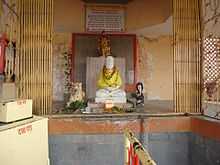Samadhi (shrine)

Samādhi (Hindi: समाधि) or samadhi mandir is the Hindi name for a temple commemorating the dead (similar to a tomb or mausoleum),[1][2][3] which may or may not contain the body of the deceased. Samadhi sites are often built in this way to honor people regarded as saints or gurus in Hindu religious traditions, wherein such souls are said to have passed into mahāsamādhi, or were already in samādhi (non-dualistic state of consciousness) at the time of death.
The tradition of India is cremation for most Hindu people at the time of death, while samadhi is generally reserved for very advanced souls, such as yogis and saints, who have already been "purified by the fire of yoga"[4] or who are believed to have been in the state of samadhi at time of death.
Gallery
-

Samadhi of Ranjit Singh in Lahore, Pakistan
-

Samadhi of Shivaji
-

Samadhi of Jijabai, mother of Shivaji
-

Samadhi of Sambhaji, son of Shivaji
-

Samadhi of Tanaji Malusare, Shivaji's general
-
Samadhi of Hambirao Mohite, brother-in-law of Shivaji
-
Samadhi of Hambirao Mohite, brother-in-law of Shivaji
-
Samadhi of Anandamayi Ma, Kankhal, Haridwar
-

Samadhi of Kanhoji Angre
-
Samadhi of Hambirao Mohite
-

Samadhi of Thorale Bajirao at Vrindavan Raverkhed
-

Samadhi Mandir of Sri Vidyaprakasananda Giri Swamy
-

Samadhi of Mahatma Gandhi, Rajghat, Delhi
-
Samadhi of Vitthal Sundar
-
Samadhi of A. C. Bhaktivedanta Swami Prabhupada in West Bengal
-

Samadhi of Mahadaji Shinde
-

Samadhi of Sadhu T. L. Vaswani
-

Samadhi Mandir of Srila Prabhupada
-

Samadhi of Bhakti Prajnana Kesava Goswami
-

Samadhi Mandir of Brahma Chaitanya
-
Samadhi of Swami Satyabhakta
-

Samadhi of Matsyendranath
-

Samadhi of Appayya Dikshita
-

Samadhi of Bhagawan Nityananda
-

Samadhi of Changdev Maharaj in Puntamba
-

Samadhi of Baba Khar Nath in Dhanauri, Narwana
-

Samadhi of Samarth Ramdas at Sajjangad
References
- ↑ Hindi dictionary (Samadhi)
- ↑ Oxford Dictionary - American English
- ↑ Oxford Dictionary - English
- ↑ Georg Feuerstein, The Encyclopedia of Yoga and Tantra (Boston: Shambhala Publications, 2011 ), p. 308.
External links
| Wikimedia Commons has media related to Samadhi (shrines). |
| Look up Samadhi in Wiktionary, the free dictionary. |








